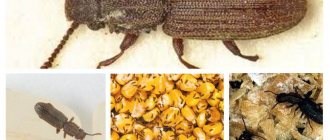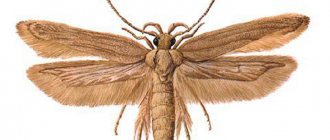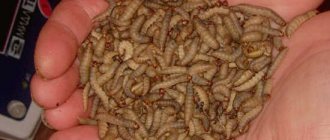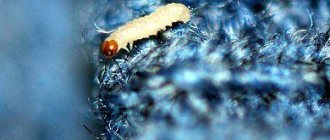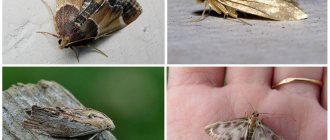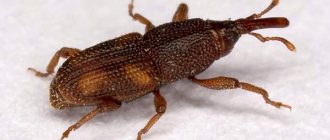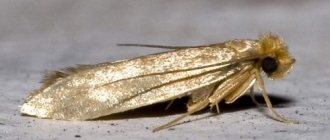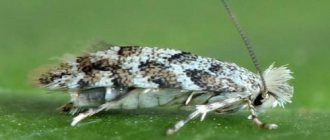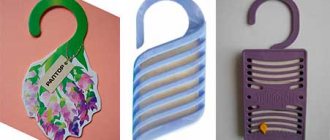Where do moths come from in the kitchen and how to get rid of them?
The principle of combating kitchen moths should combine the following actions:
- complete liquidation of affected stocks;
- destruction of flying moths;
- processing of kitchen furniture.
We can immediately conclude that in order to eliminate the harmful insect, it will be necessary to develop a whole range of measures. It is worth noting that it is simply impossible to withdraw it with one action.
Check the products in the store; they should not contain even a hint of moth larvae or cobwebs. Check the expiration date and general appearance of the products.
Very often, when housewives see a moth in the kitchen, they begin to wonder where it came from. There is no need to guess - moths always enter the house with affected products from the store. These are mainly cereals, sugar, and less often pasta. Kitchen moths cannot simply fly in from the street; they multiply and spread through larvae. More often, products that have expired and have not been treated for pests are susceptible to damage.
The basis for the fight against moths is constant preventive measures and proper organization of food storage, rather than one-time destruction.
Reasons for appearance
Many people wonder where food moths come from in a house where regular cleaning is carried out. She cannot accidentally get into the apartment from the street, since she is not capable of flying that well. Those butterflies that flutter indoors are males. Female moths move much more slowly, mostly hopping from place to place. Therefore, even if a male individual has flown into a dwelling, it will not be able to reproduce without a female one.
Food moths appear in the house along with contaminated cereals, sugar or dried fruits brought from the store.
Inside the bags there are already eggs or moth caterpillars, which then spread throughout the apartment. They get there through cuts, tears, punctures in the packaging or during packaging of goods at the factory.
Comfortable conditions for the reproduction of food moths are a temperature of +22...25°C and air humidity above 60%.
What does a food moth look like from a photo?
The food moth looks like a small butterfly, about 1 cm in size. The color is inconspicuous so that it can be easily hidden in products, from gray to brown with various inclusions.
What does food moth look like - in the photo
How long does a food kitchen moth live? Its lifespan is on average about three to four weeks, during which time it manages to lay a huge number of larvae.
What does it look like
The name “food moth” refers to insect pests belonging to the Moth family. Representatives of different species of the same family differ in appearance, but also have common characteristics:
- small size (the wingspan of the largest species does not exceed 4.5 cm, but in most species this value is about 1 cm);
- pale coloring of wings and body;
- highly sensitive antennae;
- a fleecy border along the edges of the wings;
- large organs of vision.
In our latitudes, the following types of insects can most often be found in an apartment:
- flour moth;
- mill fire;
- southern barn moth.
It is almost impossible for a non-specialist to distinguish between species characterized by small sizes and dimly colored wings. Adults look like small moths with a scaly body and grey-brown patterned wings. They are nocturnal and highly fertile: in good conditions they lay up to 400 eggs.
The larvae are small, smooth-bodied caterpillars of a light yellow color. They live and feed in flour, baked goods, any cereals, pasta, baby powder formulas, nuts, seeds, and dried fruits. It is in these products that adults prefer to lay eggs. The listed products are what the caterpillar eats. As the larva develops, it envelops itself in a cocoon, so thin threads and soft lumps-nests can be seen in spoiled products.
Most often, the sources where the insect comes from are store-bought food products. You should be especially careful when purchasing packaged bulk foods. They may be improperly stored in warehouses and stores, processed and transported incorrectly.
A small insect causes significant harm to humans and renders large volumes of food supplies unusable. Cereals or flour affected by the pest are usually thrown away. If there is little flour, then it can be thoroughly sifted, if there is a small amount of cereal, then it can be sorted out. But it is impossible to clean a large volume of product.
Food moth and clothes moth: how to distinguish
There is no need to worry about whether food moths are eating clothes. The insect feeds exclusively on food. But when food moths appear in the house, you need to carefully check the closets where clothes are stored. The fact is that food moths and clothes moths are friendly neighbors; where one insect appears, there is a high probability that a second one will appear there.
Clothes moths are a more common problem than food moths. Both species are similar in appearance, but they also have different characteristics. An adult clothes moth is a light yellow iridescent insect with a reddish down on its head. Reddish hair also borders the wings, with a span not exceeding 1 cm. Adults become blind and helpless in daylight, so during the day they hide in closets and dark places in the home.
The food moth is smaller than the clothes moth, its body length in a calm state is no more than 0.5 cm. The clothes pest has a longer body. Also, food moths have darker wings, gray-brown in color.
Also read: How to get rid of poplar moth?
Each species lives directly near its food source. Both food and clothes moths are characterized by a special type of flight. The insects flutter their wings and move in a spiral, which makes them different from other nocturnal moths.
The larvae of both species are almost identical in appearance, actively feed and develop, and as they develop, they weave a thread from which they construct a cocoon.
You can tell that there are clothes moths in your closet by looking at the colorful lumps on your clothes. These lumps are the excrement of the larvae, and they are colored because they contain colored fibers of the eaten tissue.
Organization of food storage
As already noted, moths enter the house with spoiled food in the form of larvae, and only then turn into insects that fly. To combat it, you should follow the following rules and recommendations.
- Be sure to look through all food supplies in the cabinets. If any signs of cobwebs, larvae or adult insects are found, the entire stock should be destroyed. You should not buy a huge amount of food in reserve. The maggots may not appear during storage, but if an affected batch is received, the entire stock may be damaged and will have to be thrown out.
- It is better to purchase quality products from trusted brands. It's better to pay a little more than just throw everything away.
- When purchasing, you should carefully consider the packaging of the product. The slightest hint of cobwebs or lumps should be a signal that you should not purchase such products.
- After destroying contaminated food, it is imperative to clean the kitchen. Very often, moths begin to multiply further in food spilled on the floor or table.
- When searching for moth breeding sites, you should check every package, especially in the pantry. It is in such forgotten and nondescript packages that the main breeding ground for moths may be located.
It is worth noting that the name “kitchen moth” is a collective name for several species of butterflies belonging to the moth family. At home, the granary or flour moth is mainly found. A distinctive feature of the first individual is the presence of a light stripe on the brown wings.
Methods of disposal
In order to remove food moths, you need to take the following steps:
- carefully examine all possible insect habitats;
- find a clutch of eggs;
- get rid of larvae;
- treat contaminated surfaces with insecticides.
It is also necessary to destroy adult individuals: each female moth lays up to 400 eggs in different places, from which a new generation of pests then develops.
At home, to combat insects, you can use folk methods or store-bought remedies: fragrant herbs, essential oils, traps, plates, sprays and fumigators.
Destruction of larvae
To find the places where the caterpillars live, you need to go through all the bags of groceries and conduct an audit of household preparations: dried herbs, mushrooms, apples, etc. Most often, food moths lay eggs in semolina and dried fruits, so first of all it is worth inspecting these products . Contaminated packages and bags of food supplies should be thrown away.
It is necessary to disinfect the moth habitats, and then use mechanical means to catch butterflies: traps, sticky tape, a fly swatter or rolled newspaper.
Chemical preparations for food moths
Insecticides that kill food pests can be purchased at hardware stores or specialty departments of supermarkets. Chemicals should be used according to the attached instructions.
The most effective poisons that get rid of food moths include:
- Gel or liquid con.
- Concentrated emulsion "Breeze".
- Aerosol insecticides “Armol”, “Antimol”, “Raptor: protection against moths”.
It is necessary to poison insects during the absence of all family members and pets, since some products can be hazardous to health. Before treating the room, you should protect your respiratory tract with a respirator or medical mask.
Glue trap for food moths.
Food products and all utensils that come into contact with food must be sealed. After disinfection, you need to wash your hands and rinse your mouth if the smell makes your throat sore. Then you should leave the room for a while.
The use of folk remedies
Traditional methods will also help get rid of insects. Moths cannot tolerate strong odors, so odorous oils, foods and herbs are used to combat them:
- Essential oils of lavender, geranium, cloves, wormwood. They impregnate cotton swabs and place them on kitchen cabinets, use them in aroma lamp mixtures, and add them to water for wet cleaning.
- Citrus fruit peels. The dried zest is sewn into canvas bags, which are placed in food storage areas.
- Vinegar. Shelves, cabinets, and countertops are treated with a strong solution.
- Dried herbs. Dry bouquets of fragrant herbs (dill, tansy, lavender) are hung on the walls, placed on shelves and inside cabinets with food supplies.
Substances with a strong odor repel insects, but do not have a harmful effect on them. Therefore, it is better to use folk remedies in combination with other means of combating moths.
Treating kitchen furniture against food moths
Such an event is simply necessary to destroy the larvae. After all, before the pupation process, they leave the food and spread throughout the entire territory. They can be found on walls, furniture doors and so on. For treatment, you can use various aerosols and means to kill ants and cockroaches. Today you can buy special products specifically against food moths and their larvae. Before treating furniture with chemicals and some time after, carry out wet cleaning.
After poisoning once, you should not hope that the insect will disappear. The emergence of larvae from food occurs at different times, and they can reappear in the kitchen within a couple of days. There are drugs that have a prolonged effect. They last much longer, but can be used exclusively for furniture, avoiding contact with products.
In the photo - food moth larvae
The use of chemicals alone will not have an effect unless a targeted fight is organized and the damaged products are not disposed of.
Additional measures
Methods of fighting moths
If moths appear in the house during the cold season, you can get rid of them in a simple way - frequent, long-term ventilation. The procedure is carried out after preliminary cleaning of the cabinets. Open the doors in the cabinets where food supplies and products are stored, and ventilate the room for at least 20 minutes.
The presence of moths can be detected in a completely sealed plastic bag. An amazing situation arises when larvae of different ages, pupae, and live butterflies are found in a package of buckwheat and rice. To avoid this situation, you should not buy too much food supplies. It is recommended to store cereals in glass jars with lids.
If folk remedies do not help, start using insecticides. Moths are afraid of poison even in minimal quantities. For disinfestation, use any means against moths in the apartment: aerosols, sprays. In Moscow, such drugs are sold everywhere.
Destruction of food moth butterflies
There are other situations when all measures to destroy the larvae have been taken, the food is thrown away, and the moth is still flying. This should not be ignored; butterflies should also be destroyed, as they can lay larvae. Removing adult insects is easy. Chemicals may not be used. A simple fly swatter or even a house slipper will be enough.
The photo shows food moths in the kitchen. Get rid of moths so they don't spread again
To eliminate moths in warehouses and public catering establishments, special professional aerosols are used. Destruction is carried out on a weekend, followed by general cleaning.
What moths are afraid of: repelling methods
One adult moth can lay 150-250 eggs, so it is advisable to prevent its appearance in the house. In addition to purchasing high-quality groceries, installing mosquito nets on windows, and other preventive methods, conditions in the house that are intolerable for the parasite are ensured. Specific smells help with this.
Products from the following categories repel insects:
- dry herbs and spices;
- essential oils;
- live indoor plants;
- fruit particles;
- some technical substances.
Repellents are harmless to humans, their smell does not cause negative sensations in other residents, unlike insect pests.
Spices and plants for moths
Some types of flowers and herbs (green or dried), as well as spices, have an odor that is incompatible with moths being in the house. Due to this property, they are used to repel insects by placing them in places of feeding and possible accumulation. These plant representatives include:
- wormwood (from moths, twigs and leaves are laid out in the closet, among food products, changed every 1-2 weeks);
- lavender (the flowers of the plant have a pleasant aroma for humans, but are intolerant to moths; they are effective for several months without the need to change);
- tansy (flower branches repel moths and other parasites);
- rosemary (we repel moths, but require frequent replacement);
- mint (suitable for protection against clothes moths, has a long-lasting effect);
- dill (in the form of herb or seeds);
- onions and garlic (placed in the kitchen and pantries to prevent food pests);
- red pepper (plant pods are used near cereals, bread products, flour);
- mixtures of chamomile, cloves, valerian, marigold.
Plants without a strong aroma or with a pleasant aroma for humans are placed together with clothes and fabrics. Specific substances are recommended for use in kitchen cabinets.
Twigs, flowers, moth grass are laid out in their natural form or packaged in separate fabric bags. There are special convenient sachets and sections made from natural ingredients on sale.
Essential oil for moths
The listed herbs and plants, some other representatives of the flora are effective against adult moths and their larvae in the form of essential oil. Additional oils used:
- lemon;
- orange;
- lemongrass;
- fir;
- patchouli;
- thyme;
- tea tree.
Extracts are used separately or mixed with each other. The use of essential oils is convenient, they take up less space, and retain their properties for a long time.
For 1 liter of water you need 5-6 drops of the oil composition. The solution is used to wipe the walls of cabinets, dressing rooms, kitchen furniture, and the floor. Pieces of felt, fabric, gauze swabs are dipped into the liquid, and small containers with essential components are placed on the shelves.
Houseplant against moths
Geranium grown at home effectively repels all types of moths. It is recommended to place flowerpots in rooms where food or clothes butterflies can reproduce.
The pest is negatively affected by all parts of the plant. Additionally, individual flower petals or stems are placed under carpets, furniture, between upholstery or clothing.
Another home plant with similar properties is plectranthus (“moth tree”, spur flower). The aromas it produces effectively repel moths.
Fruit peel against moths
The peel of citrus fruits (orange, lemon) is effectively used against moths. It is mainly used against food pests, less often to protect clothing. Parts of the fruit have a pleasant aroma for humans, but require frequent replacement, as they quickly expire.
To protect seasonal natural clothing and winter items, it is recommended to place them in special bags or covers. The peel of an orange or lemon is placed inside the protective devices. Additionally, fabric bags are prepared, which are filled with herbs mixed with citrus peelings.
What moths are afraid of: technical substances and other means
The following items are classified as moth repellents:
- vinegar;
- laundry and some other types of soap;
- synthetic tablets and balls;
- chestnuts;
- ultrasonic repellers.
The latter remedy works only when connected to the network; its use is justified as an additional control measure along with chemical or folk remedies.
A solution of acetic acid is prepared from the product mixed in water (proportion 1:1). The substance is used to prevent the breeding of moths near food. Kitchen furniture is periodically wiped with a cloth soaked in a solution.
Moths do not like the smell of laundry, strawberry, or dust soap. Bars of the product are laid out in places where moths accumulate. An effective method is to periodically wash the floor, furniture and other surfaces in the house with soapy water.
Special anti-moth balls and tablets, common in retail sales, are used to combat moths. Their effect on the larvae is weak. The advantage of the means is compactness and convenience, but compliance with the quantitative measures specified in the instructions is required.
Occasionally, chestnuts are used against moths, the aroma of which is elusive to humans, but unpleasant to insects. Ripe fruits are collected in the fall and laid out among clothes and furniture. It is important to dry the chestnuts because if they are raw they may develop mold.
Effective remedies for food moths in the kitchen
Modern means will help you get rid of food moths and their larvae, which must be used strictly according to the instructions and in conjunction with the cleaning and destruction of contaminated products. At the moment, there are such remedies for moths in the kitchen: sticky traps, sections, sprays. Do they all help? Let's consider the effectiveness of these drugs in order.
Food moth traps in the kitchen
A moth trap is a sticky sheet with a scent that attracts moths. A butterfly landing on this surface sticks tightly and dies. These traps are glued to the inside walls of kitchen cabinets.
The effect of such a product is designed to last 4-6 weeks, after which there will either be no space left on the trap, or it will no longer emit an odor and lose its sticky properties. The cost of such an insecticide is on average 150 rubles for two Velcro.
Reviews of glue traps for food moths
“Moths periodically appear in the kitchen, the food seems to be intact, I couldn’t find any larvae. I bought sticky anti-moth leaves at the supermarket, stuck them in the cupboards with cereals and pasta, and already got one moth. This product is not suitable for full control of insects; it is more likely for prevention.”
“An interesting remedy against moths, I glued such a plate on the kitchen shelf. Its peculiarity is that for humans it does not smell at all, but for male moths it is like a pheromone, they fly towards it headlong and stick. It is good to use for prevention so that moths do not multiply. A product of questionable effectiveness. The same sprays are more effective.”
Kitchen moth sections
Moth sections with and without scents are more suitable for storage cabinets. They mainly come in the form of a hanger hook. It will help little against food moths, as it does not affect the larvae. Valid for about 5 months, cost about 80 rubles per piece.
Reviews of sections against kitchen moths
“I put a moth section on the shelf with cereal, a couple of butterflies died, but the larvae all remained. I threw out all the cereals and treated them with Dichlorvos - more effect.”
Aerosol against kitchen food moths
Using a spray in the kitchen, especially to destroy moths whose larvae are hidden in food, is impractical and unsafe. If food is contaminated, destroy it immediately; you don't want to spray food on it. Aerosol spraying of cabinets is done in an empty kitchen where all food items are either covered or put away. After destroying the infected grains, wipe the shelves with a damp cloth, let them dry, and then spray the product. After this procedure, do not place open products directly on the treated surface! The cost of moth aerosol is around 150 rubles per bottle.
Reviews of anti-moth spray in the kitchen
“It’s been a long time since I used Raptor anti-moth spray, then the moth was on the shelf with towels, and it helped there. And then white worms appeared in the oatmeal in the kitchen - moth larvae, I realized that there was no point in splashing food on it. I threw out the porridge, wiped the box and popped it with this raptor just in case. It’s good that the moth did not have time to move into the neighboring boxes. A month has already passed - no prayer.”
How to get rid
To successfully get rid of a pest, you need to determine all its habitats in a residential area. It is useless to destroy moths alone: adult individuals die quickly anyway, leaving behind large offspring. It is important to destroy the pest at every stage of development: from egg to adult insect.
If food moths are spotted in your home, you will have to tinker: go through every jar, every package of food supplies. You should especially carefully inspect containers with flour, pasta, cereals, and nuts, since these products are the most common places where the pest infests. Food affected by worms is thrown away; eating them is contraindicated, since an actively feeding worm releases toxic waste products.
You can only tidy up those foods in which eggs were recently laid. Affected nuts, dried fruits or cereals must be carefully sorted and cleared of eggs. Then heat-treat for an hour at a temperature of 60°C. There is another method of struggle: after peeling the eggs, place the product in the freezer for several days, then pour it into a container with a hermetically sealed lid.
There are different ways to get rid of food moths:
- traps;
- ultrasonic repellers;
- spray insecticides;
- plants and herbal remedies with insect repellent odors.
Also read: What to do if a moth eats your fur coat?
The trap is an effective device with an adhesive surface. Sold in all hardware stores and markets. The packaging with the product includes instructions that indicate where and how best to attach the fishing device. The trap has the following advantages:
- does not have an odor that is irritating to humans;
- easy to apply;
- completely harmless to people;
- it's cheap.
The design of the trap is simple. The cardboard plate is treated on one side with an adhesive substance that attracts insects. The moth, having sat on the trap, gets stuck with its legs and body in the sticky mass and cannot take off. The luring substance is based on pheromones - secretion products of adult food moths, intended to attract individuals of the opposite sex. A stuck insect will not be able to mate or produce offspring. This way, the number of kitchen pests will gradually decrease.
Set up several traps, one for each section of the kitchen cabinet. As the adhesive surface fills with insects, the device is replaced with a new one. When using a trap, keep the kitchen windows closed, otherwise street insects will flock to the pheromones. It is not advisable to place the adhesive strip in a place where there is constant draft, as the attractive smell will dissipate.
The best trap that helps get rid of food moths is Aeroxon from a German manufacturer. The advantage of the device is that the adhesive surface remains usable for a long time. The product is sold both in hardware stores and via the Internet; a package with three stripes costs about 300 rubles.
An excellent tool is an ultrasonic repeller. The device is expensive, but the effectiveness is high. The winged pest disappears forever. The technical product that repels insects is completely harmless to people and animals; it can be safely installed in the kitchen.
The most expensive, but also the most effective way to get rid of food pests is to call specialists from the anti-parasitic service. In this case, no action is required from the owner; professionals will clean the living quarters of moths efficiently and quickly. However, the services of specialists are resorted to only when the invasion of a home by pests reaches large proportions, when the owners are powerless.
When breeding food moths, you need to take into account that females are capable of laying eggs not only in food, but also on kitchen cabinet shelves, in cracks and holes in furniture and other secluded places. Therefore, after complete destruction of the pest, it is imperative to carry out a thorough wet cleaning in the kitchen. All parts of kitchen furniture, all secluded places where moth eggs may be hidden, should be treated with a vinegar solution, then washed with hot water.
What to process
Some ignorant people claim that to get rid of moths it is enough to destroy the larvae, since the adult individuals themselves quickly die. But this is a false statement. Adult insects do not live long, but during their short life they manage to lay at least 150 eggs, from which caterpillars will emerge within a week. Therefore, it is necessary to destroy both adult insects and larvae, and for this, manufacturers offer a variety of chemicals.
Of the insecticides used to kill food moths, it should be noted:
- aerosols “Raptor”, “Armol Expert”, “Antimol”;
- "Combat" plates;
- chalk pencil “Mashenka”;
- microencapsulated emulsion "Get".
These products, which allow you to get rid of adult insects and larvae, are used to treat the external and internal surfaces of kitchen furniture. It should be noted that insecticidal chemicals are not the main, but only an auxiliary means of combating food pests. If you use only insecticides, you will be able to get rid of a small percentage of insects. An effective fight must be comprehensive, including a variety of means.
Insecticides are toxins to the human body. Therefore, when processing kitchen furniture, chemicals must not be allowed to come into contact with food products.
In industrial conditions, moths are combated using phosphine fumigators - electrical devices that release gases that are toxic to insects. In warehouses, grain is sprayed with contact insecticides. It is unacceptable to use such products at home.
Also read: Causes of potato moth

